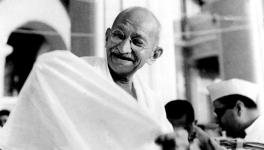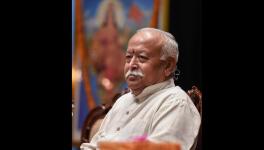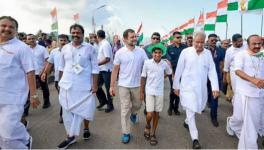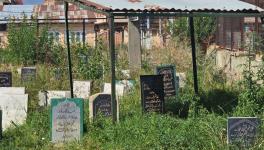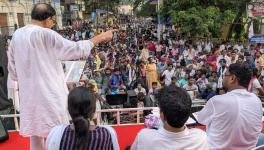Why Kashmir Seems to be Moving Towards Anarchy
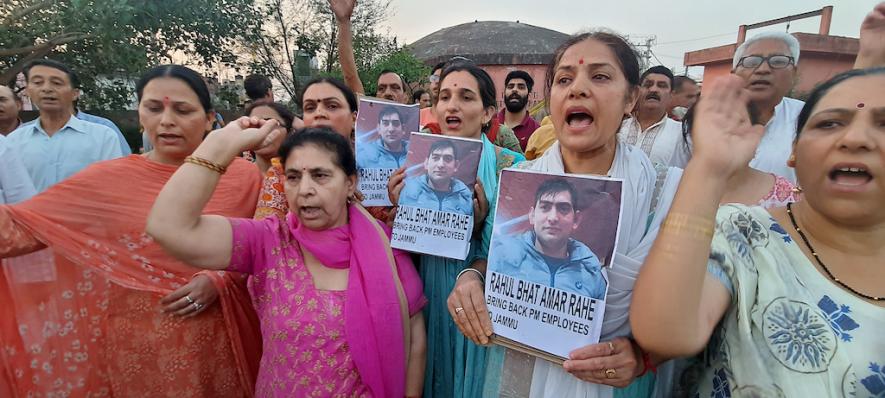
Kashmiri pandits protest against the recent killing Of Kashmiri pandit Rahul Bhat
The recent killing of Kashmiri Pandit Rahul Bhat, a government employee and Budgam resident, has stirred the valley all over again. Some other members of his community were killed in the recent past, but his murder has a significance that must be understood in its context. Bhat was among the Kashmiri Pandits who have recently returned to Kashmir after being promised government jobs under the Prime Minister’s special package, a scheme former prime minister Manmohan Singh had launched.
The Prime Minister’s package offers government jobs and a safe residential facility in transit camps to returning Kashmiri Pandits. Rahul lived in one such camp—a walled residential apartment almost segregated from other localities—not very far from Srinagar. So far, its inhabitants were living peacefully. However, their return to the valley did not seem very permanent, as most of them still maintain permanent residences at Jammu. The residents’ interactions with locals are limited, and they also prefer to work on weekdays and return to Jammu on breaks.
That said, except for a few skirmishes, these Kashmiri Pandits were generally safe. Indeed, village panchayat members and other elected representatives have also been attacked or killed in the valley, but those are attributed to the stand of militants against the constitutional processes—elected representatives of the majority community were also shot dead by militants. Still, Bhat and Makhanlal Bindroo, a well-known chemist in Srinagar, certainly were victims of targeted attacks against Kashmiri Pandits. There are pertinent questions to raise here, for these developments hold some dangerous indications.
Clueless Administration: New Reality of Kashmir
Former RAW chief AS Dulat was in Kashmir during the nineties. He was one of the most critical members of former prime minister, late Atal Bihari Vajpayee’s, Kashmir team. His book, Kashmir: The Vajpayee Years, provides a first-hand account of the early nineties and the negotiations of the regime regarding the Kashmir issue, both public and behind the scenes. In a 19 May interview with senior journalist Karan Thapar and published in The Wire platform, Dulat said that an independent “terror cell” in Srinagar is behind the rising number of militant attacks in the valley. He said the administration has no idea of who or where the members of this cell are. He said it is linked to Pakistan, and its work is far more ‘professional’ than any other attacks seen since 2019.
Pakistan has supported militancy in Kashmir since the nineties with training, arms and financial support. A clueless administration is also not new for Kashmir: It was caught unawares even during the advent of terrorism. But more factors should be considered when discussing the situation of the valley since 2019. We must also understand Dulat’s other claim, that “Kashmir is experiencing the most dangerous terrorism since August 2019”, to back which he cites the growing number of “over-ground workers connected to militant groups” and those “sympathetic to militant groups”.
In August 2019, the central government scrapped Article 370 of the Constitution and ordered mass detentions of not just whom it considered militant sympathisers but also almost the entire leadership of Kashmir. This included leaders such as Farooq Abdullah, Omar Abdullah, Mehbooba Mufti and Saifuddin Soz, who were always constitutionalists and loyal to the Indian flag, who had contested and won elections, and have a considerable following in the valley despite being labelled as “Indian stooges” by the semi-loyalists and militants. Their popularity is evident from their success in the BDC elections held last year. Their lengthy detentions after 5 August 2019, followed by abusive ostracisation by senior members of the ruling dispensation and its troll army, has reduced their stature in the valley, thereby effectively diminishing the scope and support for constitutional politics.
Coupled with the communal atmosphere created around the country, the lynchings and slander campaigns against the minority by the mainstream media have worsened the communally-charged atmosphere. It has created a situation where, as Dulat said, an organisation like “Jamaat has spread right through the administration, including the police”.
Thus, the BJP government’s tall claims of bringing peace and development while scrapping Art. 370 have fallen flat. And their attempts to stoke a frenzy in the rest of India have found enormous success. This success has induced a contrarian reaction in the valley, and that is responsible for the new phase of violent anarchy.
Fault-lines of Kashmir Files and Delimitation Politics
The Kashmir Files is the first movie that was not just promoted by Hindu right-wing organisations but by the Prime Minister and Home Minister too. Set against the backdrop of the exodus of Kashmiri Pandits, it claims to portray ‘untold truths’ of the period. The director’s declared agenda was to vilify Kashmiri Muslims in particular and the Muslim community. Indeed, Vivek Agnihotri’s film turned cinema halls into battlegrounds. Videos of derogatory slogan-mongering in theatres during screenings shrouded social media platforms for weeks.
Sanjay Tikku, who heads the well-known Kashmiri Pandit Sangharsh Samiti (KPSS), which represents the interests of Kashmiri Pandits in the valley, blamed the movie for the drastic events that followed. (Former Jammu and Kashmir chief minister Omar Abdullah echoed this sentiment.) In brief, the film fits with the agenda of the Hindutva ideological dispensation to use India’s only Muslim-dominated state to consolidate Hindu votes in the rest of India.
Riding on its successes is the Hindutva right’s larger plan to change the demographic composition of the valley. We can see a parallel in the model in Pakistan’s northern area (Gilgit and Baltistan), which has been converted into a Punjabi Sunni-dominated region, reducing its erstwhile Shia majority to a minority. In Kashmir, declarations like the plan to construct 50,000 temples have been supplemented with an attempt to fill important civil posts with non-Muslims. As Dulat said, “migrant Pandits are getting government jobs, especially in departments that are important for demographic changes”.
There are also attempts to launch divisive projects in the guise of addressing the grievances of migrant Kashmiri Pandits. For example, the new web portal to settle their property-related concerns in the valley. The portal does away with the requirement to file written complaints about surveys or measurements of migrant’s properties, which has sown more doubts in the minds of Kashmiris and made it easier for anti-India elements to incite young minds into violence.
Delimitation further aggravated tensions in the valley and confirmed apprehensions that the central government wants Jammu to dominate over Kashmir in the Assembly. The erstwhile state always had a Muslim head of state, and its politics were valley-centric. Except for Ghulam Nabi Azad, all other chief ministers belonged to the valley. This is but natural, since the valley has the highest population of the three regions, including Ladakh. However, the RSS and BJP have a support base in the Jammu region, which has the largest geographical area. For this reason, contrived allegations of Muslim appeasement and over-representation of the valley are long-standing ploys of the RSS-BJP in Kashmir.
Now, the new delimitation proposals have ignored that the valley has a higher population and increased the number of Assembly seats in the Jammu region based on its geographical extent. This is against the traditional practice everywhere in India. For instance, geographically bigger Madhya Pradesh has fewer Assembly seats than Uttar Pradesh, which is more populous.
The resentment in the valley, the recent rise in terrorist activities and the targeted killings of Pandits portend frightening prospects, but the local and central governments, filled with over-confidence in their electoral majority and a self-image built on a communal understanding of nation-building, are unfortunately in permanent denial mode.
Pawns Turn Rebels
Attacks against Pandits have always tended to create greater support for the BJP. The killings of Pandits also always captures space in the mainstream media debates. Social media buzzes with hate after each such incident. Pakistan and Muslims are blamed in ever-louder voices, and campaigns are run to escalate the effect of this shrill rhetoric. Kashmiri Pandit organisations are naturally supportive of these campaigns, and many also willingly contribute to them.
The BJP tried to emulate such old practices soon after Bhat’s killing and organised protests against Pakistan. However, it could not garner any support from Kashmiri Pandits in or outside the Valley. Instead, multiple videos of Kashmiri Pandits protesting against the Union Territory administration circulated in cyberspace. In one video, the wife of a slain Kashmiri Pandit blamed the Lieutenant-Governor (L-G) of Jammu and Kashmir, Manoj Sinha and the Home Minister of India. So, a new feature of these protests was the initial support of local Muslims. The protesters demanded justice, but not only for Rahul Bhat, for slain SPO Riyaz Bhat, a Muslim Kashmiri, too. These are unique developments in the valley and vigorously challenge the communal agenda of the Right-Wing. On day one, the protest became so boisterous that the administration resorted to the means it knows best—firing tear-gas, lathi-charge, and ultimately, the Pandits were locked up inside their camps. Over 350 Kashmiri Pandit government employees in the valley resigned to Lieutenant-Governor Manoj Sinha after Bhat’s murder, claiming they did not feel safe there. The Pandits are also shocked the L-G did not visit them in their camps.
The protests of Kashmiri Pandits against the administration were unexpected for the government. The media chose to avoid reporting on it, as it did last year when resident Kashmiri Pandits were on a prolonged hunger strike. Online trolls dug into the social media profiles of Rahul Bhat, and, to their extreme dismay, found he had protested against the killing of Rohingya people! A non-communal Kashmiri Pandit is the worst nightmare for right-wingers, and they set about to ridicule his death. However, it did not create a favourable perception and was ultimately ignored.
But the protest of the Kashmiri Pandits is still on. The KPSS is in the lead, and Sanjay Tikku has deplored the scrapping of Art. 370 and condemned the communal agenda of The Kashmir Files. He accused the film and subsequent hate-mongering as instrumental in the deteriorating atmosphere in the valley. He also appealed to the valley’s majority community to support their protest. He expressed the fear that these developments would hamper any prospects for the Kashmiri Pandits to return to live in the valley. Not just that, they would compel even resident Pandits to leave. He said the only way out is to begin a dialogue with all stakeholders in Kashmir.
What Could Happen Next?
A prominent Kashmiri Pandit has said that communal politics and the escalation of violence against the Muslims in other parts of India are bound to get “reciprocated” in the valley. Social media and satellite TV channels have connected the valley with all of India and the world so that every incident reaches mobiles and ignites a reaction. The way Kashmir is being used for communal politics beyond the valley already has an evident negative impact on the valley. The Pandits have long been used as pawns in right-wing propaganda. The pain of their exodus created a lasting impression on their minds and self-image, in which Muslims appear as the obvious villains. The gap between the two communities has widened with time.
All this has proved beneficial to the BJP, which immediately blames chief ministers for any mishap in Kashmir. Their lust for political space in the erstwhile state has turned the situation upside down. Art. 370 has been read down, and the state was reduced to a Union Territory. Today, the BJP occupies absolute power in Jammu and Kashmir, several States and at the Center. So the residents of Jammu and Kashmir have no one to take their misgivings to except the BJP-run apparatus. Yet the initial euphoria is waning rapidly. The Pandits were promised the moon—return and safety in the valley—without sufficient funds or a viable roadmap. It has created disquiet among those Pandits who still have stakes in the valley. Recently, a video in which a Panun Kashmir leader is critical of the Home Minister and the government went viral. Panun Kashmir is an organisation of migrant Pandits that has always supported the BJP. Many Kashmiri Pandits condemned the government after Bhat’s recent killing and raised questions about the director of The Kashmir Files.
Remember that those Pandits who returned to the valley under the Prime Minister’s Package have spent some time in Kashmir. They have been in contact with the local Kashmiri Muslim community and gained first-hand experience of the ground realities. They will not casually accept the official version—and this is what their ongoing protest proves.
Oblivious to the intricacy of Kashmiri society and its long history of co-existence, the present regime is not ready to accept reality and change its tactics. Their training in the shakha system and ‘bauddhik’ sessions of the RSS has handicapped their understanding of democratic co-existence within complex social structures. Their unconditional support to the capitalist class is ruining the socio-economic achievements of the past. The rupee is at its lowest, and there are war cries at the Gyanvapi and Mathura mosques, both being utilised for media management. The optics and high-decibel drama are bound to be short-lived and fail to control the economy’s down-slide. The warning is on the wall: the disastrous repercussions of this “strategy” in Kashmir can potentially throw it into another blood-curdling violent spell.
Ashok Kumar Pandey is the author of several books and a political commentator. The views are personal
Get the latest reports & analysis with people's perspective on Protests, movements & deep analytical videos, discussions of the current affairs in your Telegram app. Subscribe to NewsClick's Telegram channel & get Real-Time updates on stories, as they get published on our website.













